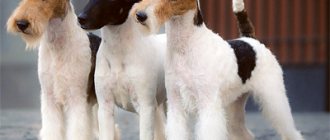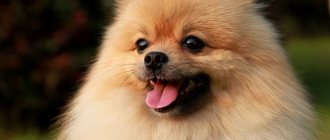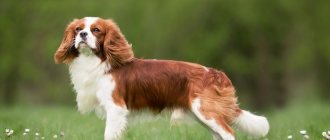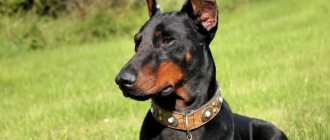The dream of almost all representatives of the fair sex, the star of the world wide web and in particular YouTube, one of the most popular breeds of our time is a dog belonging to the Pomeranian Spitz breed.
It is worth noting that this type of dog has always been highly valued and in demand.
Nowadays, dwarf Pomeranians are at the peak of their popularity. These are beautiful, cheerful and funny dogs.
History of the origin of the breed
Spitz are a group of very ancient breeds. Fossil remains of peat dogs in Switzerland and Lake Ladoga, ancient Greek and Roman images are similar to them. Spitz-like dogs were also found in Asia (Ur, China) and Africa.
The first Spitz came to England in the second half of the 18th century, but they became popular (especially those colored sandy and orange) in 1870, and from that time they began to be selected in order to achieve a reduction in size and enrichment of the “fur coat”. The dogs became more and more similar to modern Pomeranians. This was Marco, Queen Victoria’s favorite Spitz, with whom she was never separated. In 1891, the English Queen Victoria Pomeranian Club and the English standard were created: small stature and ears, light bones, very short muzzles, excess undercoat.
Following the British, the Americans began to work in the same direction. White dogs, which are still called “Eskimo Spitz,” became widespread among them. The American Breed Club appeared in 1909. Dogs that meet the American standard (compact, relatively heavy, intensely colored) are considered the best.
Russian and American dog breeders have long called Pomeranian Spitz simply dwarf, or miniature Spitz. They received their original name from the toponym “Pomerania” - a historical region of Germany.
French and German Pomeranians have an elongated muzzle, they are larger, lighter and “worse” dressed: there is no “collar”, there is not enough undercoat. The German association "German Spitz" was created in 1899. In it, the entire group of breeds was standardized by color and size.
The ICF classification classifies the Pomeranian Spitz into the category “Spitz and primitive type breeds.” The same organization considers Poms to be only a subspecies of the German Spitz, in contrast to the American Kennel Club, which claims that Pomeranians are an independent breed. The Russian Kennel Club operates according to FCI standards; at domestic exhibitions these dogs are called “German Spitz”, so we will continue to talk about the Pomeranian Spitz of the international (Russian) standard.
Interesting Facts
- Two Pomeranians were rescued from the Titanic. The information states that along with the approximately 2,240 people who boarded the Titanic, there were also 12 dogs. Unfortunately, only three dogs survived the accident: one Pekingese and two Pomeranians. One specimen was named Lady and belonged to Margaret Bechstein Hayes. The girl was returning from a trip to Europe with her friends. The other pet's name was Jane Ann. It belonged to Martina Rothschild, the wife of a clothing magnate.
- Dogs were popular among artists and musicians. Mozart's biography says that he dedicated one of the arias to his Pomeranian Spitz, Pimperl. Frédéric Chopin, inspired by his friend's tail-chasing, wrote "Waltz of a Dog." When Michelangelo painted the Sistine Chapel, his Pomeranian sat below on a satin cushion, watching what was happening.
- A dog named Jiff set a Guinness World Record for "Fastest Dog on Two Legs" in 2014. The Californian puppy ran 10 meters on his hind legs in 6.56 seconds and five meters on his front legs in 7.76 seconds. Unfortunately, Jiff's status as a top dog did not last long. Soon after, a dog named Conjo broke his record. The five-meter run on his front paws took him 2.39 seconds.
- Many dog breeds come in one or two colors, while others come in four or five. Pomeranians have 23 color combinations that are officially recognized by the American Kennel Club.
- Many puppies change color as they grow older. For example, a cream-colored animal may end up being brown and white, while a brown dog may end up being bright orange. It is impossible to know in advance whether the puppies will change colors.
- A beautiful Pomeranian named Boo has received over 17 million likes on Facebook. He also has over 618,000 followers on Instagram.
- There are more than 30 types of Pomeranians crossed with other breeds. These crossbreeds are called Pom-A-Poo, Yoran, Paperansky, Pomger, Pomston, Shiransky and so on.
- US President Theodore Roosevelt had a Pomeranian. It is said that the man often carried this pocket friend with him, which was called "Jewel".
- Pets love to run. They also like to run in circles. This is normal Pomeranian behavior. A healthy animal can accelerate up to 20 kilometers per hour.
Description of the breed
Colors of oranges
Spitz are classified as dogs of the so-called fox type; Pomeranians are the smallest representatives of these breeds.
- plain (black, cream, chocolate, white, orange, blue),
- non-monochromatic (black and tan, zone gray, blue and tan, two-color, sable),
- chinchilla
Any variants with a blue suit are outside the standard.
Breed standard
The Pomeranian is a “square” dog: the body proportions are 1:1, that is, the height and length are the same..
Head:
- the muzzle is twice as long as the skull,
- the nose is black or brown (in chocolate ones),
- lips do not protrude, black or brown,
- full set of teeth, scissor bite,
- Small triangular ears are erect and set high.
Torso:
- the back is straight, the shorter the better,
- the loin is strong, wide,
- the tail is heavily pubescent, high, thrown over the back, a double loop at the end is acceptable,
- the chest is arched, its front is well developed,
- the croup is wide, unmown,
- the stomach is moderately tucked.
- the skin is adjacent to the body, does not hang.
Legs:
- the forelimbs are strong, erect, with well-developed muscles,
- the shoulder blades are long, forming a right angle with the shoulder,
- paws are small, collected like a cat, claw pads are black or dark brown,
- the hind legs are muscular, with thick “pants” up to the tarsal (hock) joint,
- joints are strong,
- the paws are less round than those on the front legs.
Wool:
- double: long guard hair that holds the vertically “whipped” short undercoat,
- straight, long (except for the muzzle, ears, front of the legs and paws),
- a mane on the neck and shoulders, “pants” on the hind legs, a woolen whisk on the tail.
Varieties
Pomeranians are classified as miniature spitz (18 - 22 cm at the withers). There are types:
- “Fox” - a classic Pomeranian Spitz with an elongated muzzle (3 - 5 cm) - complies with the breed standard according to FCI and RKF,
- “Bear Cub” - a dog with a short muzzle (less than 3 cm) - meets the AKC breed standard.
This classification is unofficial, but for some reason the bear type of Pomeranian is becoming more popular every year both among dog breeders and among exhibition expert judges.
But selection towards ever shorter, bear-like faces harms the health of the individual dog and the entire population as a whole, leading to the degeneration of the breed!
Classes
Different puppies are born in the same litter. The characteristics of each determine its quality, according to which the dog is awarded a class: show, breed or pet. A breeder can give a guarantee for a high class (show, breed) only for a grown-up (adult) dog over a year old, which has demonstrated all the inherent qualities and has already proven itself in the ring. It makes no sense to assign classes to puppies: they change with age, but an experienced breeder can determine the show potential of an animal from 2 months.
- Show class: full compliance with the standard in appearance and character, advantages outweigh minor shortcomings, excellent pedigree; desirable for breeding.
- Breeding class: good heredity, shortcomings (not vices!) do not interfere with exhibiting, but do not count on prizes; Poms of this class are mainly females, they can be bred, but only with show dogs.
- Pet class: purebred dogs with a simple pedigree, noticeable or invisible defect (cryptorchidism, malocclusion); not suitable for breeding and exhibitions.
Types
Fox type
The type standard includes a more elongated and fox-like muzzle than other dog varieties. Imagine a stuffed toy fox with thick, fluffy cheeks, a narrow chin and a button on its nose, and you'll see the appearance of this orange. The standard describes the species' facial expression as having an "alert and intelligent nature."
Bear type
The muzzle of this decorative type is smaller, elongated and flattened, the eyes are round, set close to each other. It seems that the individuals have chubby cheeks. But this is an optical effect that occurs due to the thick hair on the cheekbones. The chin is slightly raised and the tip of the nose is raised.
Toy type
The doll-faced Pomeranian looks the same as the previous type. Therefore, they can be difficult to distinguish. The toy animal also has a shorter, rounder snout and child-like features. But the muzzle has a flatter appearance from above and does not rise upward, compared to a bear cub.
Character and behavioral characteristics
These dogs often display an independent, wolfish streak and tend to form packs. That is why they are extremely active and courageous. The light, cheerful character, like the luxurious fur coat, of modern Pomeranians is the result of breed selection. Frisky, active, Pomeranians do not sit still for a second. They are dexterous and very smart, they can even come up with some tricks on their own. They get along well with children and cats. Sometimes they like to burst into barking. Pomeranians have exceptional loyalty and a desire to please, but the latter often leads to outbursts of selfishness and aggressive jealousy towards animals that appear in the house after them.
Colors
When answering the question: how many shades of Spitz wool are there, you can get confused. There are about twelve colors in total, but it is worth noting that the final shade will be formed only by six months, after the first moult.
The main open classes for Pomeranian colors are:
- bright red, orange, cream, sable;
- black, brown, blue;
- other acceptable colors.
Education and training
Training Spitz dogs is not an easy task due to their “primitive” roots. Start working as early as possible in order to stop their natural stubbornness in puppyhood and prevent the development of aggressiveness and harmfulness. Take advantage of their strong instinct to follow the leader, prove that you are in charge - it will become easier to train the Spitz, and he will take your severity and fairness for granted. And even in this case, you risk becoming a victim of his fox cunning: he will never give up trying to command you.
How to diaper a Pomeranian
- place special diapers in places where the animal relieved itself (there can be quite a lot of them),
- you can place a rag soaked in puppy urine on it,
- after a few weeks, reduce the number of diapers,
- wipe and sanitize the floor where the puppy left a puddle,
- After another week, leave only one place where you will place “toilet” diapers.
Pomeranian Spitz: how to toilet train
Accustom your puppy to the tray, as well as to diapers, from an early age. Don't buy multiple trays to place in each room. To scare your pet away from undesirable places to relieve itself, use an antigas spray. Do not keep the puppy in the litter box for too long; it is better to take him there more often.
Basic Commands
Five-month-old puppies are already quite capable of performing all basic commands:
- approach: in hard (“Come to me!”) and soft (“Come here” or nickname) versions;
- movement nearby: to the command “Near!” the dog runs at the owner’s feet, does not run ahead, does not lag behind, does not throw himself at the feet and does not pull to the side; a team is necessary for exhibitions and comfortable, safe walks;
- taking the desired pose: the command “Sit!” useful in public transport, “Stop!” — at exhibitions, if the animal is trained in the exhibition stand; the dog must know the “release” signal (for example, a slap on the rump or “Walk!”), upon which it stops following the command;
- excerpts: for discipline during feedings and building hierarchy in the family.
Properly trained Spitz dogs look better and perform better in the ring; there is no shame in bringing them out into the public eye.
Diseases and care
Pomeranians are prone to the following diseases.
| Pathologies | Symptoms | Causes |
| atlantoaxial dislocation | pain, forced position of the head, partial or complete paralysis of the legs | injuries when jumping due to deficiencies in joint development |
| hypothyroidism | non-specific; lethargy, excess weight, bald patches with hyperpigmentation, epilepsy, etc. | thyroid disease |
| medial luxation of the patella | lameness, stiffness of movement, crunching, pain | developmental anomalies, injuries, old age |
| cryptorchidism | absence of one or both testicles in the scrotum of a male dog | underdevelopment, bruises, infections, hormonal disorders |
| testicular tumor | fertile (asexual) behavior of a male dog | trauma, infection, cryptorchidism |
| tracheal collapse | cough with phlegm, shortness of breath, exercise intolerance | hereditary deformation of the trachea |
Don’t chase fashion: too small individuals don’t live long, and dogs with very short muzzles often get sick.
Allergic or not
Despite the long, thick fur, the Pomeranian is considered conditionally hypoallergenic. If you regularly care for his coat, then there will be no dust, exfoliated skin particles, dandruff and external parasites - common causes of allergies - in the house.
Vaccinations
are carried out according to the following scheme:
- the first - for puppies at the age of 9 weeks (colostral immunity ends);
- the second - at 12 weeks;
- the third - at 6-7 months (the change of teeth is completed);
- revaccination - at 12 months.
Vaccination rules:
- vaccinate a healthy dog with normal temperature,
- two weeks before vaccination, treat it for worms (twice with an interval of 2 weeks),
- If your pom is allergic to the vaccine (lethargy, red skin), give him an antihistamine and change the manufacturer of the vaccine.
Shedding
During the junior molt (~ 3.5 - 4 months), the dog undergoes a complete change from puppy fluff to adult hair. She almost completely “undresses.” By 8 months, the Spitz is completely overgrown and until the age of three it only gains the thickness and beauty of its skin. Shedding in adult healthy dogs is highly dependent on gender and regularity of grooming. Male Pomeranians shed approximately twice a year and do not go completely bald. The condition of a female Spitz's coat depends on her estrus: she is at her best two months after or at the time of giving birth, if the female has been bred. A radical change in their coat occurs before estrus. It is not true that Pomeranians do not shed when brushed regularly. It sheds just as well, it just doesn’t leave clumps of fur on the floor or furniture.
Grooming
Caring for vertically standing orange fur that does not lie close to the body consists of:
- combing (1 - 2 times a week),
- washing (once a month, use dog shampoos),
- haircut (if necessary, with the help of a specialist groomer; a cut under the hair looks neater).
We wrote in more detail about the specifics of grooming, bathing and grooming a Spitz, as well as the nuances of shedding in a separate article.
Which clothes
There is no need to protect your pom from the cold: his thick coat will prevent him from freezing. But it is advisable and even mandatory to protect your fur coat from rain. To do this, sew or buy overalls from raincoat fabric or other water-repellent fabric. Requirements for dog clothing:
- without rough seams,
- without unnecessary decorations that catch the wool,
- preferably without synthetics.
For walks around the city in winter, buy boots for your Pomeranian to protect its paws from reagents, and the dog itself from poisoning and gastrointestinal upset; in wet weather, you can put rubber boots on your Pomeranian.
Health
In terms of health, the Miniature Spitz is a controversial breed. On the one hand, he is hardy, active and full of strength into old age. The average life expectancy of a Pomeranian is 14-16 years. On the other hand, the dog is fragile and susceptible to numerous hereditary and acquired pathologies. Among them:
- alopecia;
- black skin syndrome;
- congenital deafness;
- nanism;
- dislocations and subluxations of the knee and elbow joints;
- hypothyroidism;
- defects of the eyeball, retina, iris;
- hydrocephalus.
In addition, the dwarf Spitz often suffers from eczema, dermatitis, allergies, obesity, and disorders of the cardiovascular and digestive systems. Another weak point is teeth and gums. The Miniature Spitz suffers from caries, gingivitis, and complicated replacement of milk units with permanent ones.
Disease Prevention
Some owners believe that because Mini Spitz are decorative dogs; they do not need vaccinations or antiparasitic treatments. However, this opinion is wrong. Even indoor cats that have never gone outside can catch viruses, fleas or worms. Therefore, preventive measures are mandatory. So:
- a Pomeranian Spitz puppy is vaccinated against distemper, parainfluenza, leptospirosis, herpes, and rabies before the age of one year;
- adult Pomeranians are annually given comprehensive vaccinations against possible viral infections;
- Miniature Spitz dogs are treated every month for blood-sucking parasites, and once every 3 months for helminths.
Feeding
Feed your Pomeranian the best food you can get. Make up a natural diet of foods that are easily digestible and beneficial for the dog (lean meat, poultry and sea fish, vegetables (except potatoes), cereals, dairy products, add multivitamins.
Pay special attention to the completeness of the puppies’ diet until they are six months old, when they grow most intensively. Do not change the food often and do not make the menu too varied - this is an extra burden on the young body.
Ready-made industrial diets (wet or dry), appropriate for age and breed, buy super premium and holistic classes. They cannot be supplemented with vitamin complexes. Transfer your dog from one food to another and from natural food to dry food (and vice versa) gradually over 2 weeks.
A balanced diet is very important for a Spitz, because it needs energy no less than large dogs. We described a complete analysis of the diet in a separate article. From it you will learn how and what to properly feed Spitz dogs of all ages, and what is better not to give them, how to please a pregnant bitch, and how to support a sick animal with nutrition.
Mating, pregnancy and childbirth
Pomeranian females bleed twice a year. You can tie it the same number of times, but it’s better if it doesn’t happen every year. Never breed a bitch that is weak, sick or obese.
Pregnancy lasts, as in dogs of other breeds, about 2 months (63 ± 4 days). Whelping that begins before day 57 usually ends with the birth of dead or non-viable puppies. Protect the pregnant bitch from jumping, hitting, fighting with dogs, and hypothermia. During gestation, the bitch's immunity decreases; make sure that she doesn’t get sick, doesn’t get poisoned, and eats well.
The course of pregnancy in a Pomeranian Spitz.
| Duration, week | Signs |
| 1-3 | no external signs or changes in behavior |
| 3-4 | toxicosis, irritability, whims in eating |
| 5-6 | the belly grows, the nipples become pink, discharge from the loop is possible |
| 7-8 | mood swings: from overly friendly to unreasonably aggressive, the bitch is preparing a “nest”, she produces milk (colostrum) |
| 9 | temperature changes, a few days before giving birth the temperature drops sharply |
The small (dwarf) size of the bitch can lead to a difficult birth; you should have the phone numbers of veterinary specialists ready who can perform a caesarean section. The first puppy of the litter is born painfully (the dog whines or moans), the subsequent ones are not. After giving birth, allow the bitch to eat one afterbirth; if there are many puppies, then two, no more. Save the rest in water and give them to mommy later. Placental tissue will increase the animal's immunity.
Free the muzzles of newborn puppies from the amniotic sac, hold them upside down so that fluid comes out of the respiratory tract, and clear mucus from the nose and mouth with a clean napkin. Do not let the bitch chew the umbilical cord for a long time so that it does not injure the puppy. A healthy newborn puppy squeaks and spins.
Pomeranian litters are small in number: the norm is 1-3 puppies, a great rarity is 4. Large one-dimensional puppies are obtained only from a pair of approximately the same weight, for example, a male 2.2 kg and a female 2.5 kg. If the father is much smaller than the mother, there will be many puppies, but small ones of different sizes.
What to feed?
When buying a puppy, be sure to check with the breeder what he feeds it. A sudden change in diet in addition to a change in the usual environment will lead to stress, so it is better to give the same food for Spitz dogs as the breeders. As you get used to the new place and undergo vaccination, you can make changes to your diet and diet. And this will happen no earlier than in 2-3 weeks.
To prevent dental diseases, you need to give frozen beef knee joint. Add raw vegetables little by little – carrots, peppers, pumpkin.
The frequency of feeding depends on age:
- the first months – 4 times a day;
- from 4 months – 3 times;
- From 12 months you can switch to two meals a day.
It is strictly forbidden to give your Spitz tomatoes, cabbage, sausage, bread, ice cream, sweets and other foods from the human table.
If you choose a natural diet, then a third should come from protein foods: lean meat, fermented milk, eggs. A tenth of the diet is cereals cooked in water. The rest is vegetables and fruits.
Ready-made food makes life easier for the owner. When purchasing, pay attention to the markings: mini, small, miniature. These foods are intended for small breed dogs and are suitable for Pomeranians.
How to choose a puppy
- determine what you need the Pomeranian for: for exhibitions and breeding - take show and breeding prospects, for the “soul” - pet; choose from mature dogs;
- find a kennel with a good reputation, registered in the RKF, so as not to buy an expensive pet-class puppy;
- study the pedigrees of the dogs of the selected kennel, evaluate several litters;
- decide whether you need a female or a male: girls are better for breeding, but shed a lot, boys are less devoted, but never “undress” completely and shed unnoticed;
- choose a pet aged three months or older, no younger, with the required vaccinations, treatments for helminths and external parasites;
- evaluate the behavior (active), character (without fear of strangers), intelligence and appearance of the puppy, while taking into account his age (“baldness” of Pomeranians from 3 to 8 months is not a disease, but molting);
- evaluate the puppy’s environment and maintenance (cleanliness, quality of food, health of “neighbors”);
- touch and examine each puppy in the litter, don't limit yourself to just one.
Price and where to buy a puppy
The quality, age and gender of the Pom puppy affect its cost. So, you can find inexpensive pet Spitz dogs for 20 thousand rubles and you will get an average dog in terms of characteristics, not for the show ring or breeding. The breeding class costs from 30 thousand rubles, for 40 - 60 thousand you will buy a puppy with the makings of a show. Already titled young specimens cost more than 60,000 rubles (3,000 - 5,000 euros abroad). Bitches are valued higher than males. “Adult” dogs will cost more than small puppies.
Pomeranian kennels:
- Senior mate (Moscow, SZAO, Mitino),
- Deneb-Keitos (Kemerovo),
- GoldPom (Moscow, North-Eastern Administrative District, Otradnoe),
- Ninaros (St. Petersburg),
- From Panda Sharm (multi-breed, Ekaterinburg),
- Imperial Family (Moscow),
- Shpits&SO (Moscow),
- From the Lagoon of Dreams (Moscow, Gelendzhik).
Temperament
The character of the Pomeranian Spitz is characterized by good nature and cheerfulness. He will become a wonderful companion in games and a friend in life not only for adults, but also for children. Dogs treat children with special love and are ready to play with them with great pleasure. However, care must be taken to ensure that the child does not injure the Spitz.
Despite the fact that Pomeranians have a very strong psyche, they subtly sense the mood swings of their owner.
The small size and decorative attitude of this breed do not mean at all that this dog does not have the makings of a real dog. He always follows his owner and is ready to protect him in any danger. The Spitz has a dominant character, so if a stranger appears on his territory, he will quickly inform his owner about this with a loud bark.
Choosing a nickname
We will not touch on the official names of Pomeranians, which are given to them by breeders according to certain rules. They are recorded in stud books, under which dogs participate in exhibitions, but they are too long and pretentious. Much more convenient in everyday life are short, sonorous nicknames that are invented by the owner himself, that is, you. Nicknames should correspond to the pet’s perky character and contain rolling, ringing sounds. Avoid names with sibilants and sibilants at the beginning.
| Nicknames for Spitz girls: | Amalia, Ishtar, Athena, Bonya, Coco. |
| Suitable names for male dogs: | Outstanding personalities (Cyrus, Zeus) and even ordinary male names (Thomas, Grisha, Tim). If the pet's official name can be abbreviated, use the short version (Seb for Sebastian, Eddie for Edward). |
Owner reviews
Irina T.:
“The dog is 2.5 years old, she has been living with us for 2 years - she is a fairly independent girl. But I got used to her for about six months, tried to immediately put myself in charge of her, raised her like a big dog, without concessions. So she got used to it: she doesn’t spoil things, she doesn’t beg, she doesn’t pester her with games. But she loves me more than anyone in the family, even though I’m strict with her.”
Ekaterina A.:
“I got the dog when she was six months old. I think this is the optimal age to buy a puppy, because its advantages and disadvantages and health problems are already visible. Almost immediately I realized how much money is needed to provide normal care for even a young Pomeranian. A lot of. The story of puddles all over the house continued for a year. At first Timka was afraid, but then he got used to it and followed me everywhere. Many different toys saved the furniture from puppy teeth. His voice emerged very quickly and turned out to be loud and ringing. He himself is sensitive, affectionate, restless.”
Similar breeds
Italian Volpino are relatives of Pomeranians, but slightly larger, and come in only two monocolors: white and red.
Schipperkes are Pom-like, black shepherds that grow to the size of a small Spitz.
Alaskan Klee Kai is a small-sized decorative husky; mini individuals have the same thick fur as oranges.
Similar in appearance, but large: American Eskimo, Japanese Spitz, Eurasier, Samoyed, Alaskan Malamute, Finnish and Swedish Lapphund.
German Spitz and Pomeranian - differences
In Russia these names are synonyms, in America and Canada they are different breeds. But even in our country, classic “Germans” differ in appearance from Pomeranians.
| Pomeranian Spitz | German Spitz | |
| Height | often - miniature and small, rarely - medium, never - large | up to 35 cm |
| Wool | “cotton”, stuffed, with very thick undercoat | there is more guard hair in the skin than down hair |
| Shedding | adults hardly shed with weekly brushing | they shed anyway |
| Head | short, clear stop, ears set wide apart | elongated, “fox-like”, flattened stop, ears set narrowly |
| Teeth | missing teeth are allowed | have all teeth (42) |
| Tail | does not form rings | rings and double twisting are allowed |
Miniature Spitz: how is it different from the Pomeranian?
The Miniature Spitz is a tall variety of Spitz (18 - 22 cm at the withers). Pomeranians are simply a subspecies of miniatures (according to FCI and RKF) or a separate breed of sizes 18 - 28 cm (according to AKC). That is, these terms are synonymous unless we are talking about imported dogs of American, Canadian, or English origin (the latter are larger than the “miniature” size).
Small German Spitz and Pomeranian Spitz - differences
The Small German Spitz, or Kleinspitz, grows up to 29 cm at the withers. For Pomeranians (except for dogs of American and Canadian breeding) this is too big.
Difference between Pomeranian and Spitz?
Spitz is a whole group of dog breeds, similar in appearance, but differing in size, some proportions and purpose. The Pomeranian Spitz belongs to the smallest variety - the Miniature Spitz.
What does a Spitz need?
Any pet that owners acquire requires care and attention, good nutrition and regular walks. To make your walk safe and comfortable, it is important to choose a high-quality leash and collar. For decorative breeds, the size of which is quite small, it is necessary to choose such ammunition so that the pet can run freely, but not get into trouble. Harnesses and collars should be selected so that it is easy to control the animal and protect it in time from large and angry dogs.
Spitz collar
For a Pomeranian, a narrow collar made of genuine leather is best suited. Soft leather collar in the form of a cord with a cross-section of 3-5 mm with a buckle. Other collar options are less suitable for the breed due to its thick coat. Collars with rhinestones and stones can snag and tear out fur. The size of the collar must correspond to the circumference of the neck so that the collar does not choke the pet and at the same time he cannot wriggle out of it. As a general rule, there should be two fingers of space between the neck and the collar.
Spitz harness
The harness is suitable for very active fidgets, but with less fluffy fur. During long walks, the thick fur of the orange can become worn out and bald patches will appear. Therefore, it is necessary to purchase a harness only from high-quality materials. Preference is given to natural leather, which is least harmful to the dog’s fur coat. The harness should fit snugly to the body, but not put pressure on the body.
Leash for Spitz
It is worth choosing a light and durable leash that will not restrict the dog’s movement. A low-quality leash made of poor material can break at the wrong moment or the dog will simply chew it through. It is better to buy a leash made of leather, canvas or nylon. A roulette leash is more convenient to use than a regular one. A leash length of 5 meters is quite enough.
Muzzle for Spitz
When purchasing a set of ammunition for their new pet, many owners are puzzled as to whether a small dog needs a muzzle. Mostly Pomeranians walk without a muzzle; it is necessary if the dog does not hear commands and rushes at passers-by or other dogs.
Clothes for Spitz.
Small dog breeds are like soft toys that you want to dress in different pants, blouses and dresses. Especially now there is a rich assortment in stores. Overalls are more popular because they do not restrict movement and protect from dirt in rainy weather.
But remember, they are not toys, but living beings. Nature has endowed oranges with thick fur that protects them in both hot and cold weather. Therefore, if the dog refuses to wear clothes, you should not force him.
Spitz bed
It’s also worth purchasing a few things for your home. The dog should have its own place, comfortable and protected from drafts. There are various sunbeds, houses and bedding available for sale. In my opinion, the best option is with a replaceable cover that is easy to wash in a machine.
Photo
Briefly about the main thing
- Pomeranian Spitz is a miniature breed of decorative dogs with excellent health.
- The luxurious fur coat consists of a thick undercoat and guard hair - the main feature of the orange.
- They are active, playful, devoted dogs, and when properly trained, are non-aggressive and obedient.
- Pomeranians are prone to dominance and need strict but fair upbringing.
- Attentiveness, sensitivity and distrust make the Spitz a good guard.
Tell us in the comments what difficulties you encountered in raising your Pomeranian?
Did you like the article? Share it with your friends on social media. networks. This will help them get useful information and support our project.











